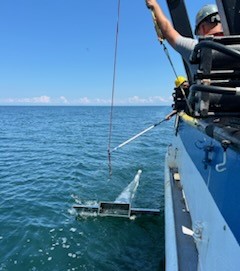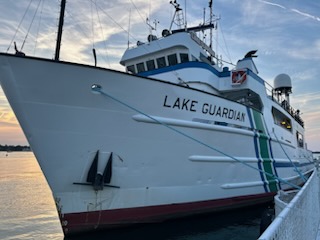Spending a week on the U.S. Environmental Protection Agency (EPA) research ship Lake Guardian on Lake Erie, Waukegan High School environmental science teacher Kate Krischke-Grobart did extensive research into microplastics.
She hopes her students will benefit from the trip.
Learning microplastics — tiny pieces of plastic less than one-fifth of an inch in size — enter the Great Lakes from the St. Lawrence River, Krischke-Grobart said they could eventually find their way into Lake Michigan and the Waukegan River.
A source of pollution, she said microplastics have grown tenfold in Lake Erie over the past few years. Though she did not learn specific statistics for Lake Michigan, the growth is similar in all five Great Lakes.
“Microplastics are made from plastic and transport toxic chemicals that get into the water and mud of the Great Lakes.” Krischke-Grobart said. “It’s not going to get better any time soon.”
She plans to do a case study with her students to learn about microplastics in the Waukegan River, which flows into Lake Michigan at the city’s lakefront, to learn about their potential impact on the community.
“We’re going to learn about the microplastics and invasive species in the (Waukegan) River system,” Krischke-Grobart said. “It will give us an idea of what will come into Lake Michigan. I want to inject these ideas into our curriculum.”
For Krischke-Grobart, the weeklong cruise on Lake Erie from July 7-13 with 14 other teachers and three research scientists was a chance to work closely with colleagues and scientific professionals to learn about invasive species and harmful algae blooms as well.
Boarding the boat in Cleveland, she said some of their time was spent ashore — including at a field laboratory of The Ohio State University — but Krischke-Grobart noted most of the week they were on the lake.
A 180-foot-long ship, the Lake Guardian is the largest research vessel on the Great Lakes, according to the EPA website. It can accommodate 42 people, including 14 crew members and 28 scientists. It has several fully equipped laboratories.
“We had the opportunity to understand the science behind the Great Lakes ecosystem,” she said. “Each day was an adventure. We got to work closely with research scientists. It was amazing to work with them.”

Krischke-Grobart said she plans to tell her students about the trip, some of what she learned and the case study in which will will be involved. Last spring, they raised trout and put them in the Waukegan River when the fish gained sufficient maturity.
Though Krischke-Grobart said she planned to propose the case study to Brian Agustin, the academic chair of the science department at the high school’s Washington campus, he did not need much convincing.
“It’s exciting what she is bringing back to her students,” Agustin said. “What she is bringing is a reward for our students. They get to focus on the health of the Waukegan River, and know it is part of environmental science. Everything around them involves science.”
While studying microplastics and other marine topics while aboard the ship, Krischke-Grobart said she got a firsthand look at how full-time research scientists approach their work.
“We learned how they study it, how they quantify it,” she said. “We saw the microplastics under a microscope and got to compare.”
Spending most of her time with a scientist delving deeply into microplastics in Lake Erie, Krischke-Grobart said she also learned invasive species in the lake like the Round Goby, a fish native to the Black Sea.
Round Goby fish threaten waters in the state of Michigan, according to that state’s website. Krischke-Grobart said she also learned about two other invasive species — quagga mussels and zebra mussels. Harmful algae blooms were also part of the research being done.




